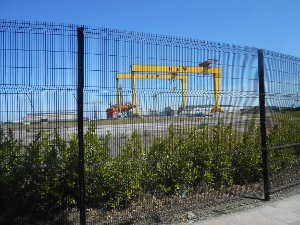 Souvenir of the Troubless
or staff. We wandered through much of the city and took some trips which gave us strong impressions of the emergence of Northern Ireland from the Troubles.
Souvenir of the Troubless
or staff. We wandered through much of the city and took some trips which gave us strong impressions of the emergence of Northern Ireland from the Troubles.
We entered Belfast, Northern Ireland, with great curiosity and some trepidation. Unlike Dublin,
which is awash in tourists and tourism, Belfast keeps to itself. We stayed in an apartment instead of a hotel, which meant that we did not enounter fellow guests  Souvenir of the Troubless
or staff. We wandered through much of the city and took some trips which gave us strong impressions of the emergence of Northern Ireland from the Troubles.
Souvenir of the Troubless
or staff. We wandered through much of the city and took some trips which gave us strong impressions of the emergence of Northern Ireland from the Troubles.
Our explorations centered on libraries and family history research; Belfast holds PRONI, the Public Record Office of Northern Ireland, so, remembering the comprehensive collection at the National Archives (formerly the Public Record Office) of the United Kingdom. we anticipated working on records at PRONI.
However, archives are not libraries. We learn this lesson again and again. Doing genealogy requires, for us, that we visit both institutions, and we try to adapt our behavior as appropriate. The best explanation we have come up with is this: libraries exist to encourage readers to find books, while archives 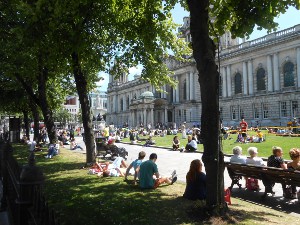 Enjoying the sunshine at City Hall
exist to protect the books from readers.
Enjoying the sunshine at City Hall
exist to protect the books from readers.
In addition to PRONI, we visited several family history and genealogy societies, including the oldest library in Northern Ireland, the Linen Hall Library, right smack in central Belfast. It was founded in 1788 and is the last remaining subscription library in Ireland. As the city grew -- and Belfast became the major port and center of industry in the 1800s and beyond -- the Linen Hall Library grew and thrived. Its original home was in the White Linen Hall, which was eventually demolished to make room for the City Hall, but it kept its name.
The Linen Hall Library developed a loyal membership but as the public library system developed it began, slowly, to decline, until in 1980, faced with the loss of all government support, a group of members developed a Save the Linen Hall Library campaign, and judging by the number of people in the library during our visit it is doing well. The library has specialization in Gaelic language and history studies, and has also acquired an excellent collection of materials from the recent troubles: posters, broadsheets, books and related materials, which are made available to researchers.
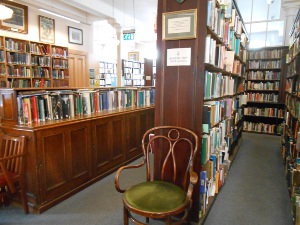 At the Linen Hall library
At the Linen Hall library
It does share some characteristics with PRONI, however. The collection contains many items which are quite old but still being used, although in fragile condition. Some readers' tables have signs saying only members may sit there, and several interesting-looking rooms are available to members: well, after all, it IS a subscription library!
Central Belfast is an exciting city in the same way that all long-established cities are exciting: elaborate facades on public buildings, statues of just about everybody, stores both large and small and lots of interesting places to eat attract windowshoppers and visitors. The city tour bus gave us an overview which helped frame our wanderings.
Lurgan
Thomas Cunningham worked in the flax industry in Ireland in the late 1600s; his sons Adam, Thomas and Walter came to the United States before the American Revolution. Adam settled in Virginia. We decided to visit Lurgan, the Northern Ireland city which had been the Irish home of the Cunningham family. Not only did it sound interesting, but it involved a train ride, and we like traveling by train.
We were looking for two books written by a local historian; they appear on lists of materials about Lurgan, but the books themselves could not be found by us in Belfast. Even Amazon had the titles but could not provide the books. Naturally, we turned to the Lurgan Public Library.
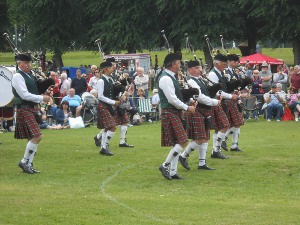 A Pipe band marching
A Pipe band marching
The library is, appropriately, on Carnegie Street, but we almost didn't get in, because the large front entrance is blocked by a metal gate firmly padlocked. Just before giving up, we asked a passing shopper, who flagged down another woman, who took us to the current front door tucked away just past where we were standing. After that it was easy: walk past the infants story hour and up to the reference desk, where the librarian had one copy of the major book on a shelf within arm's reach, and two more copies upstairs in the local history area.
We spent the rest of the morning exploring the local history materials, learning that Lurgan indeed was the center of the flax industry almost three hundred years before, and we found that somebody had had the patience to make a map which shows Shankill parish where the Cunninghams lived. We understood why the large civic sculpture in the center of town shows two flax workers.
It turned out that the annual regional Pipe Band Competition was taking place in the park by the lake just down the hill, so we joined them. There were bagpipe bands of all shapes and sizes, from grade school bands to adult groups. Each group marched in formation to the performance area, then played one or two pieces involving bagpipe and several different kinds of drums. We had been so enthralled by this that we were getting ready to leave before we noticed that there was a separate contest for drum major.
And while all of this was happening, several teams of lawn bowlers were competing on the bowling green at the edge of the park. As we have learned to say, in Ireland, "It was grand."
Derry
Derry is a remarkably attractive city in many ways. The old city wall, still
 A scene from the Troubles
intact, is a favorite spot for tourists and residents to climb and walk about to enjoy the views. Seventeenth century St. Columb's cathedral welcomes visitors who enjoy the beautiful architecture, inside and out. Two other major historical buildings, the Guildhall and the Tower, contain excellent displays recounting the history of the city from prehistoric times on. Along the riverfront walk, tents and concessions were spread about, to celebrate the Northern Ireland leg of the annual World Yacht Race, actually sailed by tall-masted clippers (according to a resident).
A scene from the Troubles
intact, is a favorite spot for tourists and residents to climb and walk about to enjoy the views. Seventeenth century St. Columb's cathedral welcomes visitors who enjoy the beautiful architecture, inside and out. Two other major historical buildings, the Guildhall and the Tower, contain excellent displays recounting the history of the city from prehistoric times on. Along the riverfront walk, tents and concessions were spread about, to celebrate the Northern Ireland leg of the annual World Yacht Race, actually sailed by tall-masted clippers (according to a resident).
Elsewhere, those historic buildings and the events would mark a city as a tourist center, but Derry has a unique recent history which has left a terrible stain. This is where pitched battles took place, starting in the 1960s, between Catholic and Protestant gangs, police forces and eventually the British military forces.
We started our Derry day with a tour bus drive through the city, which included several stops to view the many murals, each one covering the entire side of a building. Subjects include portraits of victims, inluding children, killed by bombings and bullets, views of burned houses and cars, political themes, support for law and order, and even a few bipartisan murals recently created by nationalist (Catholic) and loyalist (Protestant) artists working together.
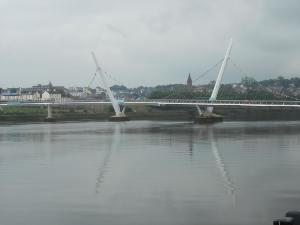 The Derry Peace Bridge
The Derry Peace Bridge
There are smaller memorials and plaques, and museums and shops feature souvenirs of the riots. Throughout the ride, we could see how the city had been divided, sometimes with high metal fences or homemade wooden fences. In some cases, lots were vacant with weeds growing because the buildings had been demolished, sometimes because they had already been bombed.
The efforts to move past these times are evident. Near the train station a statue stands with two men reaching across a chasm, almost touching hands. On some walls, violent scenes have been painted over and replaced with pictures of flowers and butterflies. There are additional displays, from gardens to texts, which talk about the need for peace and an end to violence. Perhaps the most visible symbol of the city's determination to maintain peaceful relationships is the Peace Bridge, a footbridge across the river which divides the city. This has indeed proved popular with young walkers and cyclists from opposite sides of the Foyle.
Belfast
The violence known as The Troubles is memorialized in many places throughout Belfast. Just outside the entrance to PRONI, next to a new and elaborate exhibit of the Titanic, a tall sturdy fence separates two neighborhoods. In other places vacant lots remain after burned buildings had been demolished and neighborhoods where struggles were fiercest are full of murals representing individuals and episodes of those times.
 Bonfire materials
Bonfire materials
We heard about The Marching Season which reaches its peak around the middle of July. This is the season when groups of men from the Orange order, wearing sashes or banners and carrying flags of their organizations, march through the streets of their neighborhood, often accompanied by musicians, sometimes pipes and drums. The climax is a bonfire. We saw several growing stacks of wooden pallets and kindling inside fenced lots. One late afternoon we walked down Sandy Row, a street known for Protestant/Catholic confrontations. One store had assembled its window display for the marches. But we left Belfast before the actual marches began.
The Botanic Garden comprises a lovely park, which is old and open early, and two buildings - one of which was the precursor to the Orangerie at the Royal Botanic Gardens in Kew, all white-painted iron and glass. The second building was the tropical ravine, formerly the fern house, which had been rehabilitated last in the 1980s and would soon be in need of more rehabilitation. Nevertheless, it was a MOST impressive tropical house. The slippery steep steps to the lower level were all closed off, and at any rate visitors would certainly be at risk of being strangled by the enormous plants growing down there. We admired lemons and loquats and such and were greatly impressed. Then we headed off to the Ulster Museum, just down the street from the Garden.
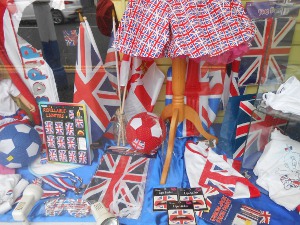 A loyalist shop window
A loyalist shop window
The first part of the Ulster Museum was a temporary exhibit of maps being used to record folk knowledge, such as local place names (Schoolmaster Pasture comes to mind!) It was truly wonderful, especially when the artists interviewed old folks to save their memories of local names. The maps were beautiful, too.
While Belfast struggles to improve its economy, rich and poor share neighborhoods throughout the city. Our apartment building shared a back yard, apparently inaccessible from the street, with several buildings.
The big question is what does the future hold for Northern Ireland? A strong economy would certainly help to build the peace. Yet Northern Ireland is the scene of past economic collapses, such as the death of the shipbuilding and linen industries. And as long as the economy remains weak, the best and the brightest will leave to seek their fortune elsewhere.